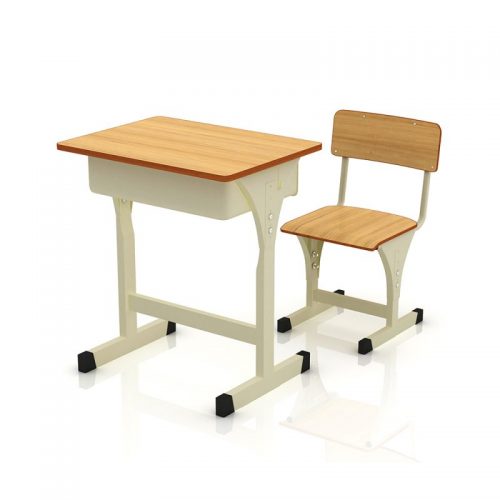Students spend most of the day sitting, so it’s important that classroom chairs and tables are comfortable and supportive. Uncomfortable seats can lead to back and neck problems — and that impacts learning.
Student chair desk combos combine a seat and writing surface for a compact seating option. They’re also easy for janitorial staff to stack and store when not in use.
1. Design
Current research supports the idea that school classroom furniture influences student engagement, health and focus. The way a classroom is set up affects the instructor’s pedagogy and how students interact with each other, so it’s important that classroom chairs and tables are well-designed.
Whether instructors use lecture-style setups with fixed seating or more collaborative settings, classroom furniture should be designed to encourage interaction between students and help teachers facilitate group projects and presentations. Students in round-table seating arrangements are more likely to communicate with one another and participate actively during lessons, while those seated in rows of fixed classroom furniture tend to listen to lectures with less attentiveness (Brooks, 2012).
When it comes to choosing classroom chairs, there’s no shortage of options, from traditional wooden designs to flexible classroom task chairs that can be adjusted to different heights to accommodate students throughout their school years. Some classroom chairs have a foot ring for students to rest their feet on if the seats are too high, preventing them from feeling uncomfortable when sitting in them long periods of time.
Tables also come in a variety of styles, from compact folding ones that are easy to store and set up when needed to larger versions with extension legs for increased stability. Many of these tables are ADA-compliant, meaning they meet federal accessibility standards for students with disabilities.
When selecting active seating options, educators should take into account that students may be excited or even apprehensive at first when they are introduced to these classroom tools. To help ensure that they’re comfortable using these seating options, instructors can set ground rules from the start about how and when they can be used.
2. Comfort
Students spend the majority of their school day sitting, so they need classroom chairs and tables that will keep them comfortable all throughout the period. Comfortable seating and tables help students focus on their teacher’s lesson, rather than on their discomfort or pain. Proper chair and table heights also ensure students are able to sit with good posture.
Several studies have shown that students learn more effectively when they can adjust their furniture to fit their body type and preferred working position. Using adjustable classroom desks and chairs and alternative seats that support different learning styles, like standing and active seating, is a great way to cultivate student engagement and foster better academic performance.
Traditional classroom chairs have a four-leg design that provides stability and support, but can take up a lot of space when in use. Those that are stackable save room and allow teachers to easily move them to other areas of the classroom when they’re not needed.
Chairs come in a variety of colors, and most are available with seat cushion, backrest or both. They may have a hard plastic seat or a more soft, padded option that’s suitable for younger students or children with sensitive skin. Many models are designed with reinforced structures and internal ribbing to improve strength and durability.
Most traditional classroom chairs are constructed with concealed rivets to avoid exposing them to students’ sensitive hands, but they may require some basic assembly. This is less time consuming when buying them in sets, which is often the best option for schools. Some types of classroom chairs, such as stools and active sitting chairs, come fully assembled.
3. Safety
The amount of time students spend sitting each day is significant, so it’s important to consider the impact on their musculoskeletal health and posture. Using classroom chairs and tables that support good posture and movement can help prevent long-term damage to their backs. School chairs should be properly sized to fit students’ bodies, and the height of tables should match chair seats to prevent strain on legs.
Safety features of classroom furniture include durable construction with rounded corners; no-snag design to avoid trapping clothing or hair; and no exposed rivets or bolt heads that could be pinched or snagged by children’s clothes, fingers or feet. Some classroom chairs have nylon floor glides, which prevent damage to floors and slides more smoothly than traditional four-legged chair legs. Other options include sled base and cantilever chair styles that are stackable for storage and daily cleaning.
Kids can be messy, so it’s helpful to look for tables with hard plastic or laminate tops that are easy to clean and wipe down. These table surfaces are a smart choice for preschoolers and kindergarten students, who are most likely to create messes with glue, markers, crayons or glitter. Older students can use a desk with a harder surface, such as wood or high quality laminate, that holds up to the wear and tear of pens, pencils, compasses and scissors.
In addition to standard school chairs, it’s worth exploring flexible seating options such as wobble stools and floor rockers that encourage students to move and shift their weight while seated, promoting better circulation and core strength for more focused attention in class. These types of active seating can also enhance learning by encouraging a more collaborative, group-based approach to instruction.
4. Materials
School chairs are constructed from a variety of materials, though polymers and plastics have become the dominant choice for classroom furniture in most institutions. Hard plastic classroom chairs offer durable seating, and they typically resist static electricity to improve comfort for students. Some hard plastic school chairs have a more flexible seat design, while others have a stiffer seat and backrest for more rigid support. Stackable classroom chairs are easy to transport and store, and most styles feature a handle built into the backrest or seat for convenient lifting and moving.
Metal and wood are other popular classroom chair materials. Typically, wood chairs have a more traditional look that coordinates with most interior decor. Many wood school chairs are GREENGUARD [GOLD] Certified, which means they meet stringent health and safety standards for kids’ use. Metal school chairs typically come in a chrome or powder-coated finish, depending on aesthetic preferences.
Generally, classroom chairs have four-leg bases that provide stable seating on hard flooring. They may also have nylon floor glides to prevent furniture damage and reduce noise. Glides are available in various sizes to suit different floor types and surface conditions, including linoleum, tile, carpet, and waxed hardwood floors. Some chairs have sled bases that move easily over carpet, while others have self-adjusting glides that adjust to create a level workspace.
Some school chairs include an optional book basket or bookrack, which helps keep classroom desks free from clutter. Several collection chairs are also designed with a backpack hook to help reduce the amount of equipment and supplies that need to be carried from place to place in the classroom. Many classroom chairs offer a textured seat and backrest to improve slip resistance.
5. Mobility
Providing students with the option to move and engage in active classroom seating arrangements supports learning. Students who have the freedom to sit, stand, rock and lounge in a comfortable chair or student desk feel more personally invested in their learning and experience improved brain activity that increases comprehension and retention.
In a flexible classroom environment, the teacher can assign seats and tables as needed for group work, lectures and individual student assignments. Modular classroom tables are available in different shapes and sizes and can be easily moved on smooth casters to fit new configurations as needed throughout the school day. Some classroom table and chair sets offer a whiteboard top for brainstorming and practice activities while others have sleek laminate tops that suit any decor.
Most classroom chairs are rated by their seat height rather than overall height to accommodate diverse learners of all sizes. Many models feature a fully adjustable backrest that can be raised or lowered to create a personalized fit, and some have a tilting seat for ergonomic positioning of the sitter. Many also swivel 360 degrees for clear sight-lines between students and the instructor or visual content.
Some classroom chairs have a built-in book storage compartment to reduce classroom clutter and make it easy for students to get to their supplies. Several collections have a book basket or a bookrack as an optional add-on to further simplify storage and transport. Most classroom chair collections have recommended maximum stacking limits and many offer a custom-designed chair dolly for safe and convenient lifting and moving support. Packaged classroom table and chair sets are a time-saving choice for outfitting a whole classroom, daycare or makerspace.


